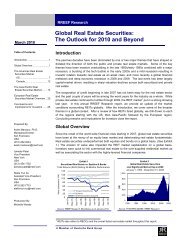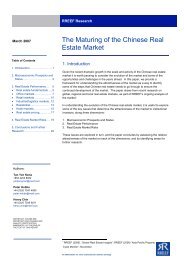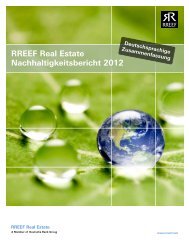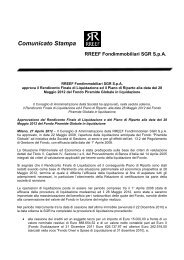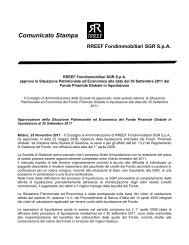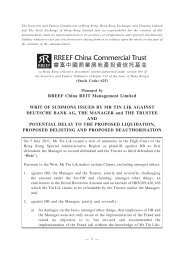Infrastructure Investments in Renewable Energy - RREEF Real Estate
Infrastructure Investments in Renewable Energy - RREEF Real Estate
Infrastructure Investments in Renewable Energy - RREEF Real Estate
You also want an ePaper? Increase the reach of your titles
YUMPU automatically turns print PDFs into web optimized ePapers that Google loves.
US$ per barrel<br />
120<br />
100<br />
80<br />
60<br />
40<br />
20<br />
Oil<br />
2000 2004 2008 2012 2016 2019<br />
Source: Global Insight<br />
Exhibit 5<br />
The Trajectory of Oil and Natural Gas Prices, 2000-2019<br />
Forecast<br />
Natural Gas<br />
Forecast<br />
Alternative <strong>Investments</strong> 7<br />
$ per million BTUs<br />
12<br />
10<br />
8<br />
6<br />
4<br />
2<br />
2000 2004 2008 2012 2016 2019<br />
Crude oil and natural gas prices are highly volatile. This volatility characterizes both markets<br />
s<strong>in</strong>ce <strong>in</strong> each case supply and demand are highly <strong>in</strong>elastic with respect to price while demand<br />
is highly <strong>in</strong>come-elastic. This implies that changes <strong>in</strong> <strong>in</strong>come lead to changes <strong>in</strong> demand,<br />
where the new equilibrium requires a large movement <strong>in</strong> price.<br />
High oil and natural gas prices were factors driv<strong>in</strong>g the robust pace of <strong>in</strong>vestment <strong>in</strong><br />
renewables <strong>in</strong> 2007 and 2008. The fall <strong>in</strong> oil and natural gas prices <strong>in</strong> late 2008 and early<br />
2009 was also widely viewed as a factor driv<strong>in</strong>g down <strong>in</strong>vestments <strong>in</strong> renewables more<br />
recently.<br />
The projections for oil and natural gas prices are critical to the outlook for renewables. In the<br />
near term, the collapse <strong>in</strong> the global economy has led to weak demand for energy. Weak<br />
demand comb<strong>in</strong>ed with relatively high <strong>in</strong>ventories should weigh on oil and natural gas prices<br />
through 2010. As economic recovery ga<strong>in</strong>s traction by late 2010 and firms up even more by<br />
2011, especially among energy-importers, we expect a significant rebound <strong>in</strong> oil and natural<br />
gas prices. Follow<strong>in</strong>g a period of <strong>in</strong>tense concern around supply, the potential strength of the<br />
demand recovery should support much higher fuel prices <strong>in</strong> 2011 and beyond. We also expect<br />
a structural <strong>in</strong>crease <strong>in</strong> demand for energy, primarily from Asian emerg<strong>in</strong>g markets. This<br />
implies that oil and gas prices are likely to rema<strong>in</strong> at relatively high levels. This is also<br />
supported by our demand and supply analysis of the broader energy markets <strong>in</strong> the preced<strong>in</strong>g<br />
section.<br />
2. Capital Costs<br />
Given the large fixed-cost nature of renewable <strong>in</strong>frastructure assets, the cost of capital is<br />
critical to the economic feasibility of these projects. Effectively, the cost of renewables is<br />
almost entirely capital costs. The capital cost per megawatt of renewables capacity is often<br />
higher than that of power generated by fossil fuels. The higher cost of capital <strong>in</strong> the current<br />
environment has made renewables less economically viable. As a result of the current<br />
f<strong>in</strong>ancial crisis, it has become very difficult to f<strong>in</strong>ance large-scale, capital-<strong>in</strong>tensive renewable<br />
energy <strong>in</strong>frastructure projects. Many of the banks specializ<strong>in</strong>g <strong>in</strong> the underwrit<strong>in</strong>g of such<br />
projects have been hit hard by this crisis. In the current environment, it is hard to f<strong>in</strong>ance any<br />
project. Arguably, smaller ones are more difficult to obta<strong>in</strong> f<strong>in</strong>anc<strong>in</strong>g than larger ones. Our<br />
expectation, however, is that as the f<strong>in</strong>ancial crisis ends, as banks repair their impaired<br />
balance sheets and as banks become profitable, f<strong>in</strong>anc<strong>in</strong>g will become more readily available<br />
for such large-scale <strong>in</strong>frastructure assets.<br />
3. Carbon Pric<strong>in</strong>g<br />
At the center of climate policy is carbon pric<strong>in</strong>g. Pric<strong>in</strong>g greenhouse gas emissions <strong>in</strong>ternalizes<br />
the externality that is the cause of global warm<strong>in</strong>g. This pric<strong>in</strong>g can be accomplished either<br />
through a carbon tax or cap-and-trade.





